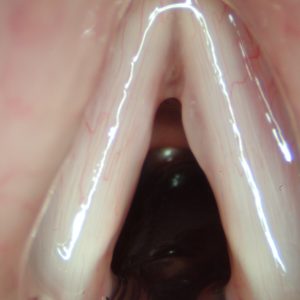Vocal polyps are soft growths that usually develop on one vocal fold and can appear suddenly or gradually. They are commonly caused by a single traumatic vocal event (like shouting or heavy coughing), but ongoing voice strain, reflux, and smoking can also contribute. There are several types of polyps, and they differ based on how they form and how long they’ve been present.
A hemorrhagic polyp happens suddenly when a blood vessel bursts inside the vocal fold—often during a single loud yell or intense vocal effort. It fills with blood and can cause immediate hoarseness or loss of voice. A fusiform polyp is longer and sausage-shaped, forming gradually from chronic voice overuse, especially without vocal rest. A fibrotic polyp is dense and firm, usually the result of an older hemorrhagic polyp that healed poorly over time.
Symptoms of all polyps include hoarseness, a rough or uneven voice, vocal fatigue, or the feeling of something stuck in the throat. Small polyps may shrink with strict voice rest, hydration, and anti-inflammatory measures. However, persistent polyps often require microlaryngoscopy for precise surgical removal. In some cases, a blue laser or KTP laser may be used to minimize damage and speed recovery. Most patients heal in 1–2 weeks and benefit from voice therapy afterward to prevent recurrence.

Fusiform Polyp

 YouTube Channel
YouTube Channel
